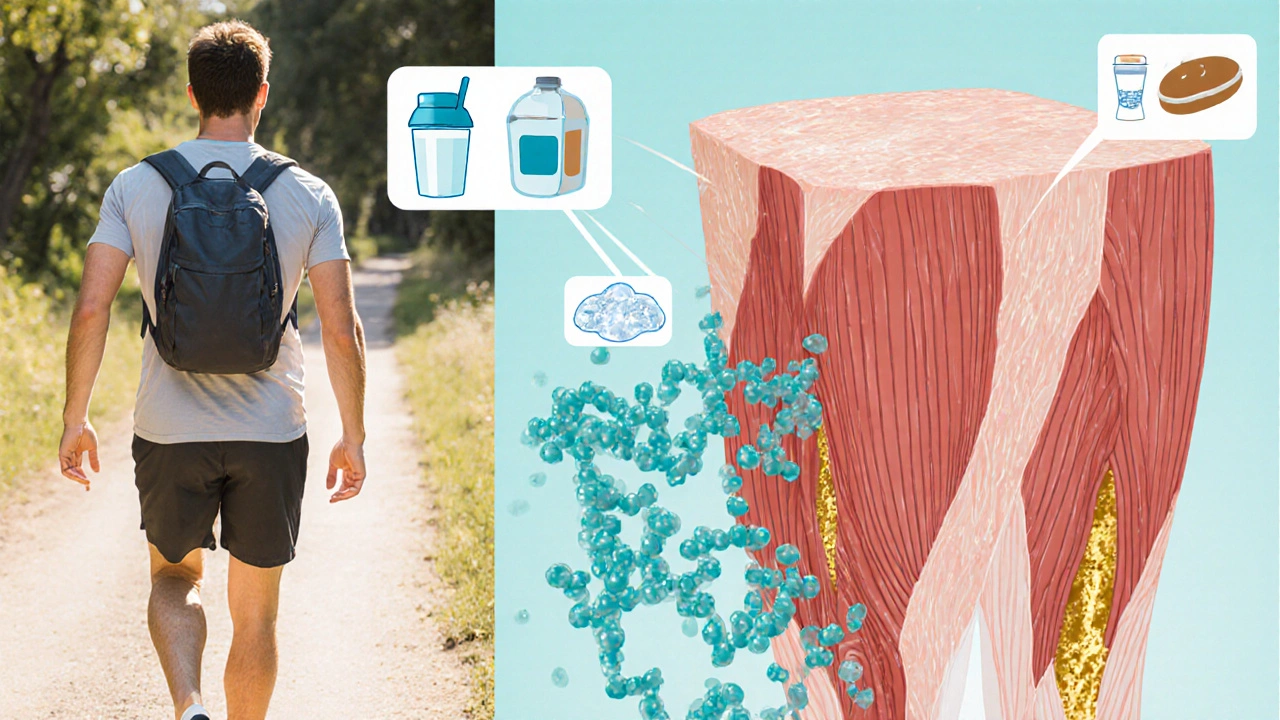
Week Off Workout Calculator
Estimated Weight Changes After 7 Days Off
Quick Takeaways
- A single week without exercise usually adds water weight, not fat.
- Calorie balance, glycogen stores, and hormone shifts drive short‑term changes.
- Maintain protein intake and stay active in daily life to keep muscle loss minimal.
- Use the checklist below to protect your body composition during a break.
Why a Week Off Doesn’t Automatically Mean Fat Accumulation
When you wonder if you’ll gain weight after a week off, the answer isn’t a simple yes or no. The body is a dynamic system where several factors-calories, water, glycogen, and muscle proteins-interact. In most cases, the extra pounds you see on the scale are water, not a new layer of adipose tissue.
Understanding weight gain an increase in body mass that can come from fat, muscle, water, or glycogen stores helps you see why a short break rarely adds a pound of fat.
Calorie Balance: The Core Equation
At the heart of any weight change is the calorie equation: calories in minus calories out. If you continue eating the same amount while your activity drops, you’ll create a modest surplus. A surplus of 3,500 calories is roughly one pound of fat, but a week of reduced activity typically creates a surplus far smaller than that-often just a few hundred calories.
That small surplus usually goes toward replenishing glycogen the stored form of carbohydrate in muscles and liver, which binds water. Each gram of glycogen holds about three grams of water, so restoring depleted stores can add 1‑2kg (2‑4lb) of water weight.
Water Retention and Hydrostatic Weight
During intense training, you lose water through sweat and breathe out water vapor. When you stop, your body retains more fluid to keep tissues hydrated. This is called hydrostatic weight the mass contributed by water stored in cells and extracellular spaces. It’s why you might notice a tighter shirt after a rest day, even though your fat stores haven’t changed.
The shift is temporary. Once you resume regular training and sweat again, the excess water is expelled within a few days.

Muscle Mass and Muscle Memory
Muscle loss is a concern for many who take a week off, especially if they’re already lean. The body’s catabolic response to inactivity is modest over just seven days. Research shows that strength loss is roughly 5‑7% after two weeks of complete rest, and even less after one week.
More importantly, the concept of muscle memory the ability of previously trained muscle fibers to regain size and strength faster after a break means that any small loss you experience will be quickly reclaimed once you train again.
Metabolism: Does It Slow Down Overnight?
Your basal metabolic rate (BMR) is primarily driven by lean body mass, not day‑to‑day activity. A week without cardio or weightlifting won’t significantly drop your BMR. However, a slight dip in metabolism the sum of all energy‑expending processes in the body can happen because you’re moving less overall (fewer steps, less fidgeting).
The impact is minimal-perhaps a 2‑3% reduction in daily calorie burn, which translates to a few dozen calories. Over a week, that’s not enough to cause measurable fat gain.
How Rest Days Influence Body Composition
Rest days are a built‑in part of any smart training program. They allow muscle fibers to repair, hormones to reset, and the nervous system to recharge. Rest days planned periods without structured exercise that support recovery become counter‑productive only when they turn into prolonged inactivity with poor nutrition.
Strategic rest can actually improve long‑term body composition by preventing overtraining, which can spike cortisol and promote fat storage.
Practical Tips to Keep the Scale Stable
- Maintain protein intake (0.8‑1.0g perlb of body weight) to protect muscle.
- Stay lightly active-walk, stretch, or do a short mobility routine daily.
- Watch sodium; excess can exacerbate water retention.
- Keep calorie intake close to maintenance; a 200‑300kcal buffer is safe.
- Hydrate adequately; paradoxically, drinking more water reduces fluid‑hold.

Real‑World Numbers: What the Data Shows
A 2023 study of 48 recreational lifters compared a seven‑day detraining period to a control group that continued low‑intensity activity. The detraining group gained an average of 1.2kg (2.6lb) of body mass, but 85% of that was water, not fat. Fat mass increased by only 0.1kg (0.2lb), a statistically insignificant change.
Another trial with endurance athletes found that glycogen repletion added about 2kg (4.4lb) of weight after a rest week, again largely water bound to carbohydrate stores.
Checklist: Protect Your Body During a Week Off
- ✅ Eat protein at each meal (20‑30g).
- ✅ Keep a gentle daily step goal (5,000‑7,000 steps).
- ✅ Limit high‑sodium snacks.
- ✅ Stick to maintenance calories (+/- 200kcal).
- ✅ Drink at least 2L of water.
When a Week Off Could Lead to Real Fat Gain
If the break coincides with a holiday binge, a dramatic calorie surplus, or a complete stop to all movement, the body can start storing excess energy as fat. In those scenarios, the compounding effect of high carbs, high fats, and low activity may push you beyond the small buffer we discussed.
Therefore, the key is not the break itself, but what you feed the body while you’re resting.
Bottom Line
A one‑week pause from structured workouts is unlikely to add a noticeable amount of fat. Most of the weight you see will be water linked to glycogen restoration and slight fluid shifts. By keeping protein steady, staying lightly active, and not over‑eating, you’ll come back to the gym with the same muscle and possibly even a refreshed mindset.
| Component | Average Change | What It Means |
|---|---|---|
| Water (hydrostatic weight) | +1‑2kg (2‑4lb) | Temporary, disappears once training resumes |
| Glycogen | +300‑500g (0.7‑1.1lb) stored with water | Supports quick energy when you start exercising again |
| Fat | +0.1‑0.2kg (0.2‑0.4lb) | Usually within measurement error; not a real gain |
| Muscle protein | −0.5‑1% of total muscle mass | Negligible; quickly regained thanks to muscle memory |
Frequently Asked Questions
Will I lose muscle if I skip a week of training?
You may lose a tiny fraction of muscle protein-about 0.5‑1%-but the loss is negligible and quickly reversed thanks to muscle memory. Keeping protein intake high and doing light activity helps preserve mass.
Why does the scale go up even if I didn’t eat more?
The increase is mostly water linked to replenished glycogen and reduced sweat loss. This “hydrostatic weight” is temporary and disappears once you resume regular exercise.
Should I cut calories during a rest week?
Only a slight adjustment (200‑300kcal below maintenance) is advisable if you’re worried about a surplus. Drastic cuts can hurt recovery and muscle preservation.
Can a week off affect my metabolism?
Your basal metabolic rate stays largely unchanged over seven days. Any drop is limited to the calories you burn through everyday movement, which is why staying lightly active matters.
What’s the best light activity on a rest day?
A brisk 20‑minute walk, gentle yoga, or a mobility routine keeps blood flow moving without taxing your recovery systems.
